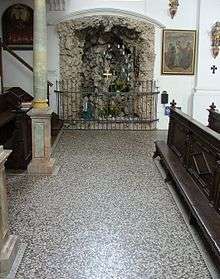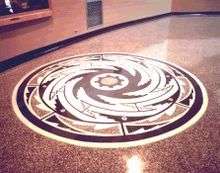Terrazzo

Terrazzo is a composite material, poured in place or precast, which is used for floor and wall treatments. It consists of chips of marble, quartz, granite, glass, or other suitable material, poured with a cementitious binder (for chemical binding), polymeric (for physical binding), or a combination of both. Metal strips divide sections, or changes in color or material in a pattern. Additional chips may be sprinkled atop the mix before it sets. After it is cured it is ground and polished smooth or otherwise finished to produce a uniformly textured surface.
History
Terrazzo proper
Terrazzo was created by Venetian construction workers as a low cost flooring material to surface the patios around their living quarters. Originally consisting of scrap marble chips set in clay and sealed with goat milk, production of terrazzo became much easier after the introduction of electric industrial grinders and other power equipment in the 1920s.
Archaeological use of the term
Archaeologists have adopted the term terrazzo to describe the floors of early Neolithic buildings (PPN A and B, ca. 9,000–8,000 BC) in Western Asia constructed of burnt lime and clay, colored red with ochre and polished. The embedded crushed limestone gives it a slightly mottled appearance. The use of fire to produce burnt lime, which was also used for the hafting of implements, predates production of fired pottery by almost a thousand years. In the early Neolithic settlement of Cayönü in eastern Turkey ca. 90 m² of terrazzo floors have been uncovered. The floors of the PPN B settlement of Nevalı Çori measure about 80 m². They are 15 cm thick, and contain about 10–15% lime.
These floors are almost impenetrable to moisture and very durable, but their construction involved a high input of energy. Gourdin and Kingery (1975) estimate that the production of any given amount of lime requires about five times that amount of wood.[1] Recent experiments by Affonso and Pernicka[2] have shown that only twice the amount is needed, but that would still amount to 4.5 metric tons of dry wood for the floors in Cayönü. Other sites with terrazzo floors include Nevalı Çori, Göbekli Tepe, Jericho, and Kastros (Cyprus).
Production

Terrazzo artisans create walls, floors, patios, and panels by exposing marble chips and other fine aggregates on the surface of finished concrete or epoxy-resin. Much of the preliminary work of terrazzo workers is similar to that of cement masons. Marble-chip, cementitious terrazzo requires three layers of materials. First, cement masons or terrazzo workers build a solid, level concrete foundation that is three to four inches deep. After the forms are removed from the foundation, workers add a one-inch layer of sandy concrete. Before this layer sets, terrazzo workers partially embed metal divider strips in the concrete wherever there is to be a joint or change of color in the terrazzo. For the final layer, terrazzo workers blend and place into each of the panels a fine marble chip mixture that may be color-pigmented. While the mixture is still wet, workers toss additional marble chips of various colors into each panel and roll a weighted roller (100–125 lbs.) over the entire surface.
In the 1970s, polymer-based terrazzo was introduced and is called thin-set terrazzo. Initially polyester and vinyl ester resins were used as the binder resin. Today, most of the terrazzo installed is epoxy terrazzo. The advantages of this material over cementitious terrazzo include a wider selection of colors, 1⁄4 inch to 3⁄8 inch installation thickness, lighter weight, faster installation, impermeable finish, higher strength, and less susceptibility to cracking. The disadvantage of epoxy resin–based terrazzo is that it can only be used for interior, not exterior, applications. Epoxy-based terrazzo will lose its color and slightly peel when used outdoors, whereas cement-based terrazzo will not. In addition to marble aggregate blends, other aggregates have been used, such as mother of pearl and abalone shell. Recycled aggregates include: glass, porcelain, concrete, and metal. Shapes and medallions can be fabricated on site by bending divider strips, or off site by water-jet cutting.
When the terrazzo is thoroughly cured, helpers grind it with a terrazzo grinder, which is somewhat like a floor polisher, only much heavier. Slight depressions left by the grinding are filled with a matching grout material and hand-troweled for a smooth, uniform surface; it is then cleaned, polished, and sealed.[3]
See also
- Mosaic
- Portuguese pavement
- Engineered stone
- International Association of Marble, Slate and Stone Polishers, Rubbers and Sawyers, Tile and Marble Setters' Helpers and Marble Mosaic and Terrazzo Workers' Helpers
- Bio-Glass
References
| Wikimedia Commons has media related to Terrazzo. |
- ↑ Gourdin, W. H.; Kingery, W. D. "The Beginnings of Pyrotechnology: Neolithic and Egyptian Lime Plaster". Journal of Field Archaeology. 2 (1–2): 133–150. doi:10.1179/009346975791491277. Retrieved 15 June 2013.
- ↑ Affonso, Maria Thais Crepaldi; Pernicka, Ernst (2001). "Neolithic Lime Plasters and Pozzolanic Reactions: Are They Occasional Occurrences?". In Boehmer, Rainer Michael; Maran, Joseph. Lux orientis: Archäologie Zwischen Asien und Europa. Festschrift für Harald Hauptmann zum 65. Geburtstag. Internationale Archäologie: Studia honoraria Volume 12. Rahden/Westfallen, Germany: Verlag Marie Leidorf. pp. 9–13. ISBN 9783896463920. OCLC 646779465. Retrieved 15 June 2013.
- ↑ "Cement Masons and Terrazzo Workers". Occupational Outlook Handbook, 2012–13 Edition. Bureau of Labor Statistics, U.S. Department of Labor. 29 March 2012. Retrieved 15 June 2013.